
For companies to keep pace with the current upheavals, good teamwork and thus the relationships between team members are crucial for team success. Following the Business Model Canvas, the innovation consultancy Strategyzer has now designed new tools that can make collaboration more productive, on-site and remotely.
We must innovate collaboratively to overcome the challenges we face every day in our organizations and society. There is no alternative. A team that works and delivers is the new building block of any success; today’s challenges have become too complex to be tackled alone. But Stanford professor Behnam Tabrizi explained back in 2015 in a Harvard Business Review article that 75% of cross-functional teams are considered dysfunctional. According to an Atlassian report 50% of meetings are considered unproductive and a waste of time.
My experience as a digital project leader has demonstrated to me that working together itself takes work. When projects and teams suffer, it is rarely due to a lack of technology or budget, but mainly because human aspects, internal to the team and in the relationships with other teams, have been neglected.
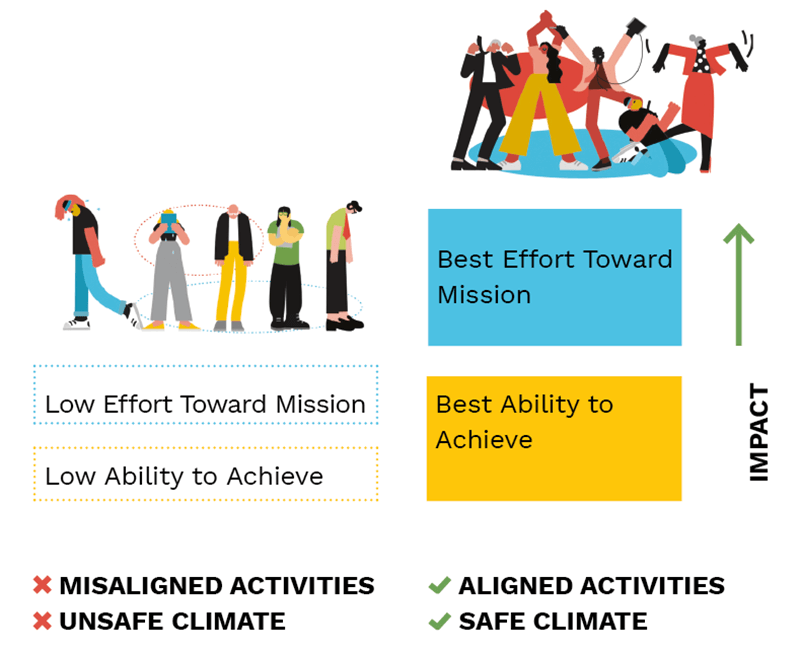
Séverine Assous (www.illustrissimo.fr)
Today’s challenges are too daunting for isolated talents working in pseudo teams. Complex problem solving requires real teamwork and that starts by building solid team alignment and a safe climate.
First, mutual understanding, i.e. the constant need to maintain a high level of alignment between key stakeholders. Anything teams achieve, from having a party to building an airplane, is a by-product of team alignment. Alignment is the process of making individual contributions converge to achieve a shared goal for mutual benefit.
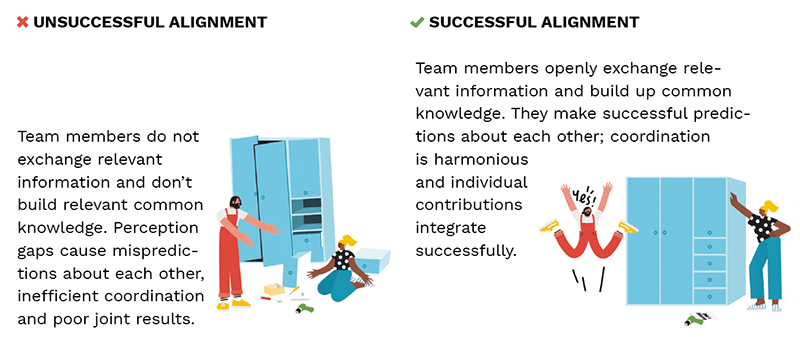
Séverine Assous (www.illustrissimo.fr)
Second, psychological safety, or the belief that the team is safe for interpersonal risk- taking and speaking up with ideas, questions and constructive criticism.
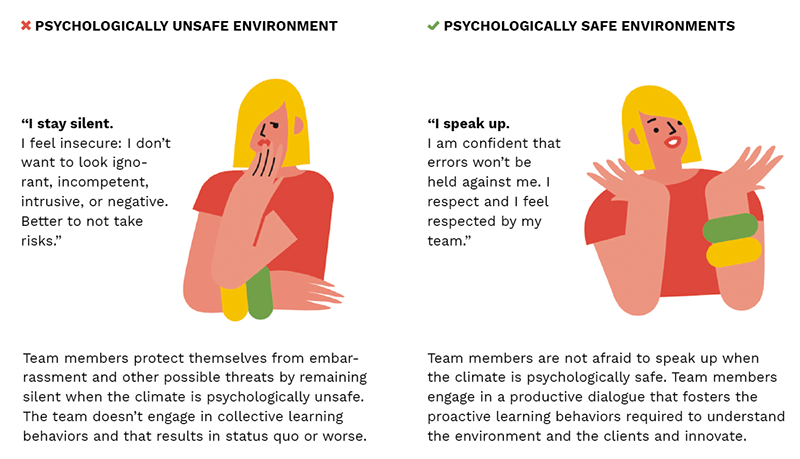
Séverine Assous (www.illustrissimo.fr)
Tools such as the Business Model Canvas, first published by my colleague Alex Osterwalder in 2005, can help teams design, test and launch innovative products and services. But what about the human side of innovation journeys? How can we create alignment, build trust and communicate better to get more effective results as a team and rediscover the pleasure of working together? From our point of view, there was a gap here. That’s why, together with Alex Osterwalder, I have now developed several “High-Impact Tools for Teams”. In the following, I outline a few examples.
Create alignment with the Team Alignment Map (TAM)
You don’t achieve a team goal efficiently when team members don’t truly and fully understand what each other are doing. Either we are aligned or we are not.
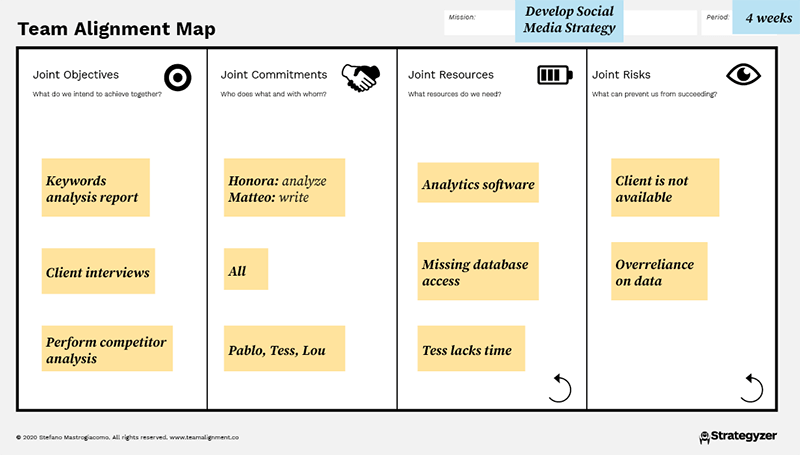
The Team Alignment Map is a co-planning tool. It helps team leaders and members increase mutual understanding in 4 key areas to optimize the contribution of each participant.
Hold short alignment sessions, where the team answers these questions together, with specific and visible indications on the map. This helps the team stay on the same page, eliminates members operating with perception gaps, on mistaken assumptions, and reduces the coordination problems that undermine projects in the execution phases.
The Map is divided into four columns, each containing a trigger question:
1. Joint Objectives:
What do we intend to achieve together?
2. Joint Commitments:
Who will do what (and for whom)?
3. Joint Resources:
What resources do we need to do our parts?
4. Joint Risks:
What might prevent us from succeeding?
Build trust with the Team Contract
We’ve all been in meetings where people don’t speak up. The problem is that you can’t spark collective intelligence without sharing knowledge, and people won’t share (freely and accurately) when they don’t feel safe in their team. Trust among participants has a direct impact on the ability to innovate as a team, as Charles Duhigg vividly explained in his article “What Google learned from its quest to build the perfect team”.
Keeping silent is rational when the team climate is unsafe: No one likes to be perceived as arrogant, intrusive or ignorant. This type of silence triggers a whole series of events. When members don’t speak up, they’re not sharing key information, the level of shared knowledge remains low, so collective learning remains low. As a result the team cannot solve complex problems and the status-quo is maintained. No innovation in sight.
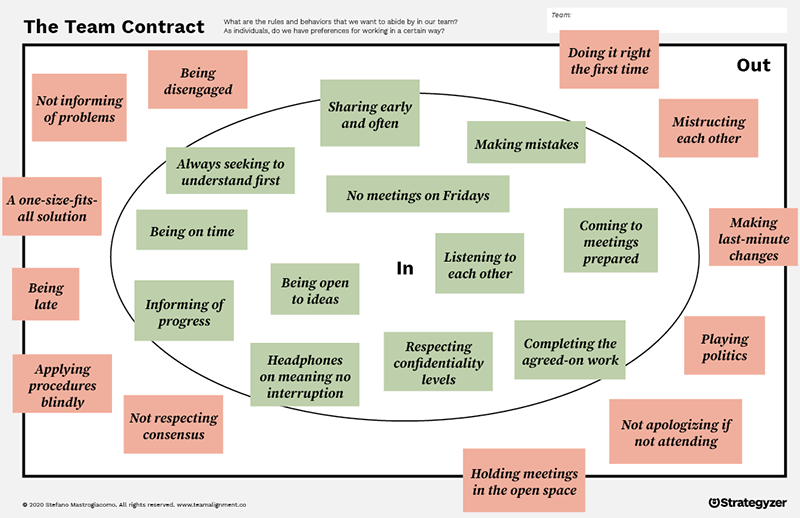
This is the raison d’être of our second tool, the Team Contract, which helps team leaders and members build a safer team climate by establishing the team rules of the game in advance, visually, together, by answering the following questions:
- What are the rules and behaviors that we want to abide by in our team?
- As individuals, do we have preferences for working in a certain way?
Responding as a team to these two questions before starting the project journey contributes to creating a safer team climate. Joint expectations on behaviors, decision-making, ways of working, etc., become explicit from the start and everyone knows which way the wind is blowing. It also helps reduce potential friction in diverse teams, since every voice is heard from the beginning (thanks to the second question).
Once the basics of alignment and trust are in place, leaders and teams can go on and refine and improve their team communication process with further tools such as the Fact Finder (an inquiry tool to ask good clarification questions), the Nonviolent Request Guide (a template to manage conflict and disagreement constructively), and the Respect Card (a checklist of techniques to express respect and recognition).
All together these tools can help participants improve their journey both in terms of team activities and team climate. The result is simple, but powerful: Each team member can feel listened to, is given a real opportunity to contribute to the best of his or her abilities and bring about successful innovation.
About the Author

Stefano Mastrogiacomo is a management consultant, professor, and author. He has been leading digital projects and advising project teams in international organizations for more than 20 years, while teaching and doing research at the University of Lausanne and at the Ecole Hôtelière de Lausanne, University of Applied Sciences Western Switzerland. His interdisciplinary work is anchored in project management, change management, psycholinguistics, evolutionary anthropology, and design thinking. Stefano is passionate about human coordination. For the new book ”High-Impact Tools for Teams”, which he co-wrote with Alex Osterwalder, he designed the new tools and methods outlined in it to enable more effective teamwork.


![“Does Everyone Hear Me OK?”: How to Lead Virtual Teams Effectively iStock-1438575049 (1) [Converted]](https://www.europeanbusinessreview.com/wp-content/uploads/2024/11/iStock-1438575049-1-Converted-218x150.jpg)





















![“Does Everyone Hear Me OK?”: How to Lead Virtual Teams Effectively iStock-1438575049 (1) [Converted]](https://www.europeanbusinessreview.com/wp-content/uploads/2024/11/iStock-1438575049-1-Converted-100x70.jpg)






